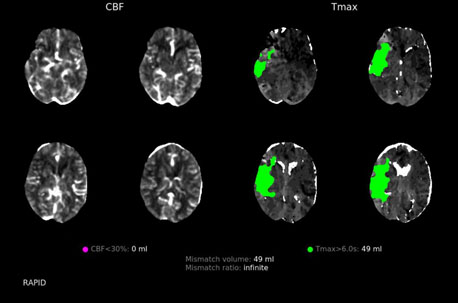Project RAPID Hawaii: A Statewide Collaboration on Acute Stroke Care
Queen’s Medical Center Punchbowl
Project RAPID Hawaii: A Statewide Collaboration on Acute Stroke Care
Project Funded by §321H-4 Neurotrauma Special Fund from October 2020 to September 2022
Until 2015, the only proven treatment for ischemic stroke, which occurs when a blood vessel supplying blood to the brain is blocked by a clot, was intravenous (IV) tissue plasminogen activator (tPA), also known as clot buster medication. However, treatment with IV tPA alone has only a ten to thirty percent (10%-30%) success rate at fully restoring blood flow to the brain with large vessel occlusions (LVOs). LVOs, if left untreated, have the highest rate of mortality or severe disability. In 2015, several landmark clinical trials demonstrated that manual removal of the blockage within six (6) hours of symptom onset through a procedure called mechanical thrombectomy (MT) dramatically increases the chance of survival with independent level of functioning. The RAPID software can also be used to identify patients with wake-up strokes or unwitnessed onset, who would be beyond the four and a half (4.5) hour time window from time-last-known-well for tPA treatment and to exclude tPA treatment in patients with suspected stroke mimics, such as seizure, complicated migraine, or psychogenic response.
Project Goals
Support implementation of RAPID software to improve statewide access to timely expert stroke evaluation and treatment of eligible patients with Mechanical Thrombectomy (MT) by working directly with recipient Hawaii hospitals and iSchemaView. The 6 Hawaii hospitals include Wahiawa General Hospital, Kuakini Medical Center, Kona Community Hospital, Kauai Veterans Memorial Hospital, Hilo Medical Center and Castle Medical Center.
Educate providers about use of advanced imaging techniques such as the RAPID software to determine eligibility for MT up to 24 hours after symptom onset.
Educate the public about the signs and symptoms of stroke, the need for urgent evaluation at the hospital, and the availability of advanced treatments like MT.
Figure 1. RAPID Scan
Demographic and Evaluative Data
As of July 2021
- 1,177 students and community members received the FAST stroke education message.
- 56 physicians, 31 technologist, and 1 stroke coordinator were trained on use of RAPID software.
- 1,053 RAPID scans were successfully processed.
- 6 patients were identified as eligible for MT.
- 39 patients were identified as eligible for tPA.
- 80 patients were identified as not eligible for MT. These patients were able to remain in their local hospital for care instead of being unnecessarily transferred to another hospital.


